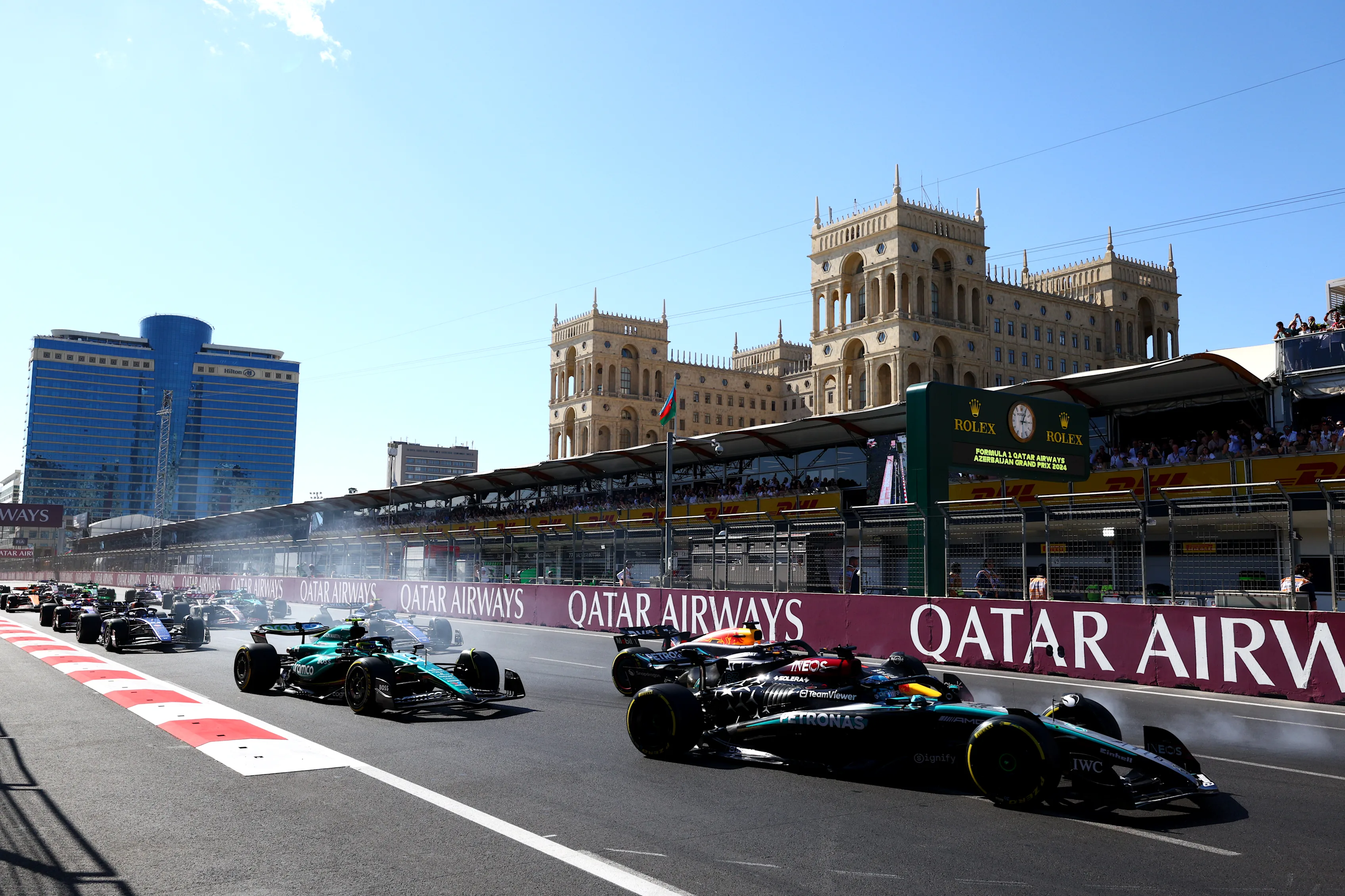How the Azerbaijan Grand Prix became a modern classic
Few races combine history and high speed like the Azerbaijan Grand Prix. From Sergio Pérez’s victories to cars threading through the Old City walls, Baku is a race that feels both timeless and modern.

Since its debut in 2016, the Baku City Circuit has firmly established itself as one of Formula 1’s most distinctive venues. Baku offers a spectacle where high-speed drama plays out against a backdrop of ancient city architecture and modern skyscrapers, creating a race that feels both timeless and contemporary.
On track, Baku has produced some of Formula 1’s most unpredictable moments – from wild collisions to last-lap drama and victories snatched in the dying moments. The city circuit is unforgettable for its setting, with cars racing past the UNESCO-listed Old City, skirting the Caspian Sea and gliding past the futuristic flame towers, a spectacle for fans whether in the grandstands or watching from home.
Few circuits have shaped the championship narrative as dramatically in such a short span, ensuring Baku’s place as a fan favourite.
Drama, chaos and the ‘King of the Streets’
Few circuits deliver unpredictability like Baku. Safety Cars, late-race crashes and title-shaping twists are etched into its history.
In 2017, the Grand Prix descended into chaos when Lewis Hamilton and Sebastian Vettel clashed behind the Safety Car, a flashpoint that defined their title fight. Lance Stroll was dramatically passed by Valtteri Bottas at the finish line, but was able to celebrate his maiden podium in F1, the youngest rookie ever to reach the rostrum.
The following year, Baku delivered again when Red Bull team mates Daniel Ricciardo and Max Verstappen collided on the main straight, forcing both cars to retire. Then in 2021, as the championship battle with Hamilton was on a knife edge, Verstappen’s sudden tyre failure sent him into the barriers just five laps from victory. The drama set up a two-lap sprint that Sergio Perez coolly converted into one of his most satisfying wins.
That triumph cemented Perez’s reputation as F1’s “King of the Streets”. He remains the only repeat winner in Baku and has built his legacy on mastering circuits where precision and nerve matter most. In 2026, he will return to the grid with Cadillac, carrying that reputation into a bold new chapter of his career.
From fortress walls to flame towers
What makes Baku so distinctive is the way history, culture and modernity collide along the circuit.
At one end of the lap, drivers pass the ancient stone walls of the Icherisheher, or Old City, a UNESCO World Heritage site that dates back to the 12th century. One of the calendar’s most demanding sequences comes here at Turns 8, 9 and 10, where the track narrows to just 7.6 metres and leaves almost no margin for error. Drivers weave through the medieval stone walls beneath the Maiden Tower and past the Shirvanshahs’ Palace, landmarks that connect the city to centuries of history.
It is a breathtaking test of accuracy and focus, and one of the most striking visuals in F1, with modern machines flying past centuries-old architecture in a scene that feels more like a postcard than a racetrack.
From there, the track spills out onto grand boulevards built during Baku’s 19th-century oil boom, where neoclassical and baroque mansions in European style stand in an unmistakably eastern setting. These ornate façades showcase the city’s role as a historic crossroads between east and west.
The lap opens onto the Caspian Sea promenade, where futuristic towers and flame-shaped skyscrapers light up in fiery reds and oranges at night, a glowing tribute to Azerbaijan’s nickname “The Land of Fire” and its modern, energy-rich identity.
This architectural blend makes Baku a living reflection of F1 itself, a sport that honours tradition and thrives on innovation.
A festival for fans
The Azerbaijan Grand Prix has quickly earned a reputation as one of the most vibrant and enjoyable race weekends to attend. Fans will be welcomed into a city-wide celebration as Baku fuses motorsport with street culture, food and nightlife.
From the grandstands near the Old City to the waterfront views and buzzing F1 Fanzone, Baku becomes an all-encompassing Formula 1 festival. Cafes and restaurants spill with racegoers, nightlife takes on the rhythm of race week, and headline concerts at Baku Crystal Hall keep the celebrations rolling late into the night.
The Azerbaijan Grand Prix has cemented its place on the calendar by combining unpredictable racing with a setting and atmosphere that feel entirely unique. That mix is why Baku belongs – a race where Formula 1 makes history on streets already steeped in it.

Next Up
Related Articles
 F1 AcademyElla Stevens tops the inaugural F1 ACADEMY Rookie Test
F1 AcademyElla Stevens tops the inaugural F1 ACADEMY Rookie Test Piastri confident McLaren 'aligned' on 'papaya rules'
Piastri confident McLaren 'aligned' on 'papaya rules' FIA Team Principals press conference – Azerbaijan
FIA Team Principals press conference – Azerbaijan  Driver marketHadjar responds to 2026 Red Bull seat reports
Driver marketHadjar responds to 2026 Red Bull seat reports Norris leads Piastri and Leclerc in first Azerbaijan GP practice
Norris leads Piastri and Leclerc in first Azerbaijan GP practice F2: Jack Crawford takes second pole of 2025 in Baku
F2: Jack Crawford takes second pole of 2025 in Baku